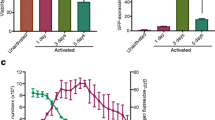Abstract
It has been demonstrated that a chimeric antigen receptor (CAR) can directly recognize the CD19 molecule expressed on the cell surface of B-cell malignancies independent of major histocompatibility complex (MHC). Although T-cell therapy of tumors using CD19-specific CAR is promising, this approach relies on using expression vectors that stably integrate the CAR into T-cell chromosomes. To circumvent the potential genotoxicity that may occur from expressing integrating transgenes, we have expressed the CD19-specific CAR transgene from mRNA using a high throughput microelectroporation device. This research was accomplished using a microelectroporator to achieve efficient and high throughput non-viral gene transfer of in vitro transcribed CAR mRNA into human T cells that had been numerically expanded ex vivo. Electro-transfer of mRNA avoids the potential genotoxicity associated with vector and transgene integration and the high throughput capacity overcomes the expected transient CAR expression, as repeated rounds of electroporation can replace T cells that have lost transgene expression. We fabricated and tested a high throughput microelectroporator that can electroporate a stream of 2 × 108 primary T cells within 10 min. After electroporation, up to 80% of the passaged T cells expressed the CD19-specific CAR. Video time-lapse microscopy (VTLM) demonstrated the redirected effector function of the genetically manipulated T cells to specifically lyse CD19+ tumor cells. Our biomedical microdevice, in which T cells are transiently and safely modified to be tumor-specific and then can be re-infused, offers a method for redirecting T-cell specificity, that has implications for the development of adoptive immunotherapy.







Similar content being viewed by others
References
C. Baum, J. Dullmann, Z. Li, B. Fehse, J. Meyer, D.A. Williams, Blood 101, 2099 (2003)
C.J. Cohen, Y.F. Li, M. El-Gamil, P.F. Robbins, S.A. Rosenberg, R.A. Morgan, Cancer Res. 67, 3898 (2007)
L.J.N. Cooper, Blood 112, 2172 (2008)
L.J.N. Cooper, M.S. Topp, L.M. Serrano, S. Gonzalez, W. Chang, A. Naranjo, Blood 101, 1637 (2003)
L.J.N. Cooper, Z. Al-Kadhimi, L.M. Serrano, T. Pfeiffer, S. Olivares, A. Castro, Blood 105, 1622 (2005)
A. Craiu, D. Scadden, Methods Mol. Biol. 423, 301 (2008)
K.A. DeBruin, W. Krassowska, Biophys. J. 77, 1213 (1999)
M.L. Edelstein, M.R. Abedi, J. Wixon, R.M. Edelstein, J. Gene. Med. 6, 597 (2004)
N. Elango, S. Elango, P. Shivshankar, M.S. Katz, Biochem. Biophys. Res. Commun. 330, 958 (2005)
J.C. Fratantoni, S. Dzekunov, V. Singh, L.N. Liu, Cytotherapy 5, 208 (2003)
S. Hacein-Bey-Abina, C. Von Kalle, M. Schmidt, F. Le Deist, N. Wulffraat, E. McIntyre, N. Engl. J. Med. 348, 255 (2003)
S. Holtkamp, S. Kreiter, A. Selmi, P. Simon, M. Koslowski, C. Huber, Blood 108, 4009 (2006)
C.M. Kowolik, M.S. Topp, S. Gonzalez, T. Pfeiffer, S. Olivares, N. Gonzalez, Cancer Res. 66, 10995 (2006)
W. Krassowska, P.D. Filev, Biophys. J. 92, 404 (2007)
S. Li, Curr. Gene Ther. 4, 309 (2004)
P.C.H. Li, D.J. Harrison, Anal. Chem. 69, 1564 (1997)
C.U. Louis, M.K. Brenner, Curr. Pharm. Des. 15, 424 (2009)
M.S. Mahmoud, R. Fujii, H. Ishikawa, M.M. Kawano, Blood 94, 3551 (1999)
J.F. Miller, W.J. Dower, L.S. Tompkins, Proc. Natl. Acad. Sci. USA 85, 856 (1988)
D.A. Mitchell, I. Karikari, X. Cui, W. Xie, R. Schmittling, J.H. Sampson, Hum. Gene Ther. 19, 511 (2008)
M. Mockey, C. Goncalves, F.P. Dupuy, F.M. Lemoine, C. Pichon, P. Midoux, Biochem. Biophys. Res. Commun. 340, 1062 (2006)
A.C. Nathwani, K.M. Gale, K.D. Pemberton, D.C. Crossman, E.D.G. Tuddenham, J.H. McVey, Br. J. Haematol. 88, 122 (1994)
R.J. O’Reilly, Nat. Med. 14, 1148 (2008)
M.A. Pule, B. Savoldo, G.D. Myers, C. Rossig, H.V. Russell, G. Dotti, Nat. Med. 14, 1264 (2008)
L.M. Serrano, T. Pfeiffer, S. Olivares, T. Numbenjapon, J. Bennitt, D. Kim, Blood 107, 2643 (2006)
H. Singh, L.M. Serrano, T. Pfeiffer, S. Olivares, G. McNamara, D.D. Smith, Cancer Res. 67, 2872 (2007)
H. Singh, P.R. Manuri, S. Olivares, N. Dara, M.J. Dawson, H. Huls, Cancer Res. 68, 2961 (2008)
J. Stepinski, C. Waddell, R. Stolarski, E. Darzynkiewicz, R.E. Rhoads, RNA 7, 1486 (2001)
B.G. Till, M.C. Jensen, J. Wang, E.Y. Chen, B.L. Wood, H.A. Greisman, Blood 112, 2261 (2008)
H. Wang, A.K. Bhunia, C. Lu, Biosens. Bioelectron. 22, 582 (2006)
Acknowledgements
Support from CCSG Grant (CA16672), RO1 (CA124782, CA120956), R21 (CA129390, CA116127), DOD (PR064229), The Alex Lemonade Stand Foundation, The Alliance for NanoHealth Competitive Research, The Burroughs Wellcome Fund, The Gillson Longenbaugh Foundation, The Leukemia and Lymphoma Society, The Lymphoma Research Foundation, The Miller Foundation, The National Foundation for Cancer Research, The Pediatric Cancer Research Foundation, The National Marrow Donor Program, The William Lawrence and Blanche Hughes Foundation, Longenbaugh Foundation. We thank Rice University for access to the cleanroom to make the micro devices.
Author information
Authors and Affiliations
Corresponding author
Electronic Supplementary materials
Below is the link to the electronic supplementary material.
Video of the electro-transfer process of CAR transgene mRNA using HiTMeD. Extended cables deliver the electrical signal to HiTMeD that operates in a fume hood to maintain sterility. Sampling of electroporated cells is performed using multi-well plates. (MPG 4323 kb)
Time lapse video microscopy redirected killing of adherent tumor targets by CAR+ T cells after electro-transfer. (MPG 4035 kb)
Rights and permissions
About this article
Cite this article
Choi, Y., Yuen, C., Maiti, S.N. et al. A high throughput microelectroporation device to introduce a chimeric antigen receptor to redirect the specificity of human T cells. Biomed Microdevices 12, 855–863 (2010). https://doi.org/10.1007/s10544-010-9440-3
Published:
Issue Date:
DOI: https://doi.org/10.1007/s10544-010-9440-3




